Construction of Roller Compacted Concrete Dams in Hot Arid Regions
Abstract
:1. Introduction
2. Al- Khanaq RCC Dam Construction
3. Calculation Basis
3.1. Mathematical Modeling
3.2. Numerical Modeling
3.3. Stress Analysis
4. Finite Element Modelling
4.1. Initial Conditions
4.1.1. Evaluation of the Foundation Temperature
4.1.2. RCC Placing Temperature
4.2. Material Properties
4.3. Recorded and Estimated Air Temperatures and Wind Velocities
5. Results and Discussion
5.1. Foundation Temperatures
5.2. Dam Body Temperature
5.3. Rerservoier Temperature:
5.4. Stress Analysis
6. Conclusions
Author Contributions
Funding
Conflicts of Interest
References
- Saetta, A.; Scotta, R.; Vitaliani, R. Stress Analysis of Concrete Structures Subjected to Variable Thermal Loads. J. Struct. Eng. 1995, 121, 446–457. [Google Scholar] [CrossRef]
- Carvera, M.; Oliver, J.; Prato, T. Simulation of Construction of RCC Dams I: Temperature and Aging. J. Struct. Eng. 2000, 126, 1053–1061. [Google Scholar] [CrossRef]
- Carvera, M.; Oliver, J.; Prato, T. Simulation of Construction of RCC Dams II: Temperature and Aging. J. Struct. Eng. 2000, 126, 1062–1069. [Google Scholar] [CrossRef]
- Luna, R.; Wu, Y. Simulation of Temperature and Stress Fields During RCC Dam Construction. J. Constr. Eng. Manag. 2000, 126, 381–388. [Google Scholar] [CrossRef]
- Waleed, A.M.; Jaafar, M.S.; Noorzaei, J.; Bayagoob, K.H. Effect of placement schedule on the thermal and structural response of RCC dams using finite element analysis. Advanced in geotechnical engineering with emphasis on dams, highway materials, and soil improvement. In Proceedings of the Geo Jordan Conference 2004, Irbid, Jordan, 12–15 July 2004; pp. 94–104. [Google Scholar]
- Noorzaei, J.; Bayagoob, K.H.; Thanoon, W.A.; Jaafar, M. Thermal and stress analysis of Kinta RCC dam. Eng. Struct. 2006, 28, 1795–1802. [Google Scholar] [CrossRef]
- Jaafar, M.S.; Bayagoob, K.H.; Noorzaei, J.; Thanoon, W.A. Development of Finite Element Computer Code for Thermal Analysis of Roller Compacted Concrete Dams. J. Adv. Eng. Softw. 2007, 38, 886–895. [Google Scholar] [CrossRef]
- Gaspar, A.; Lopez, F. Methodology for a probabilistic analysis of an RCC gravity dam construction. Modelling of temperature, hydration degree and ageing degree fields. Eng. Struct. 2014, 65, 99–110. [Google Scholar] [CrossRef]
- Su, H.; Wen, Z.; Yan, X.; Liu, H.; Yang, M. Early-warning model of deformation safety for roller compacted concrete arch dam considering time-varying characteristics. Compos. Struct. 2018, 203, 373–381. [Google Scholar] [CrossRef]
- Zhang, X.F.; Li, S.Y.; Chen, Y.L.; Chai, J.R. The development and verification of relocating mesh method for the computation of temperature field of RCC dam. Adv. Eng. Softw. 2009, 40, 1119–1123. [Google Scholar] [CrossRef]
- Li, M.; Guo, X.; Shi, J.; Zhu, Z. Seepage and stress analysis of anti-seepage structures constructed with different concrete materials in an RCC gravity dam. Water Sci. Eng. J. 2015, 8, 326–334. [Google Scholar] [CrossRef] [Green Version]
- Mirzabozorg, H.; Hariri-Ardebili, M.A.; Shirkhan, M. Impact of solar radiation on the uncoupled transient thermo-structural response of an arch dam. Sci. Iran. 2015, 22, 1435–1448. [Google Scholar]
- Cavusli, M.; Ozolcer, I.H.; Kartal, M.E.; Karabuult, M.; Coskan, S. The effect of reservoir length on the earth quake behavior of roller compacted concrete dams. Online J. Sci. Technol. Jan. 2017, 7, 111–118. [Google Scholar]
- Zhang, X.; Liu, Q.; Zhang, X.; Li, Y.; Wang, X. A Study on Adiabatic Temperature Rise Test and Temperature Stress Simulation of Rock-Fill Concrete. J. Math. Probl. Eng. 2018, 2018. [Google Scholar] [CrossRef]
- Kuzmanovic, V.; Savic, L.; Mladenovic, N. Computation of Thermal-Stresses and Contraction Joint Distance of RCC Dams. J. Therm. Stresses 2013, 36, 112–134. [Google Scholar] [CrossRef]
- Žvanut, P.; Turk, G.; Kryžanowski, A. Effects of Changing Surrounding Conditions on the Thermal Analysis of the Moste Concrete Dam. J. Perform. Constr. Facil. 2016, 30, 04015029. [Google Scholar] [CrossRef] [Green Version]
- Incropera, F.P.; Lavine, A.S.; Bergman, T.L.; DeWitt, D.P. Fundamentals of Heat and Mass Transfer, 5th ed.; John Wiley & Sons: New York, NY, USA, 2002. [Google Scholar]
- Sergerlind, L.J. Applied Finite Element Analysis; John Wiley and Sons: New York, NY, USA, 1984. [Google Scholar]
- Ishikawa, M. Thermal Stress Analysis of a Concrete Dam. J. Comput. Struct. 1991, 40, 347–352. [Google Scholar] [CrossRef]
- Conrad, M.; Malkawi, A.H. Investigations on the modulus of elasticity of young RCC. In Proceedings of the Fourth International Symposium on Roller Compacted Concrete (RCC) Dams, Madrid, Spain, 17–19 November 2003. [Google Scholar]
- CEB-FIB. MC90(1990): CEB-FIB Model Code 1990; Comité Euro-InternationalduBéton: Lausanne, Switzerland, 1990. [Google Scholar]
- Maikawi, A.I.H.; Mutasher, S. A direct tensile strength for roller compacted (RCC) gravity dams. In Proceedings of the Fourth International Symposium on Roller Compacted Concrete (RCC) Dams, Madrid, Spain, 17–19 November 2003. [Google Scholar]
- Tatro, S.B.; Bombich, A.A.; Hess, J.R. Case Histories of Mass Concrete Thermal Studies. Final Report of the Structures Laboratory of the ERDC/SL, TR-00-8, Engineer Research and Development Center (ERDC); US Army Corps of Engineers (USACE): Washington, DC, USA, 2000. [Google Scholar]
- Bayagoob, K.H. Thermal and Structural Analysis of RCC Dams. Ph.D. Thesis, University Putra Malaysia, Serdang, Malaysia, 2008. [Google Scholar]
- Duffie, J.; Beckman, W. Solar Engineering of Thermal Processes; Wiley: New York, NY, USA, 1980; pp. 1–140. [Google Scholar]
- U.S. Bureau of Reclamation. Thermal Study Mass Gradient Andsurface Gradient Analysis Procedure and Examples, ETL 1110-2-542; Bureau of Reclamation: Washington, DC, USA, 1997.
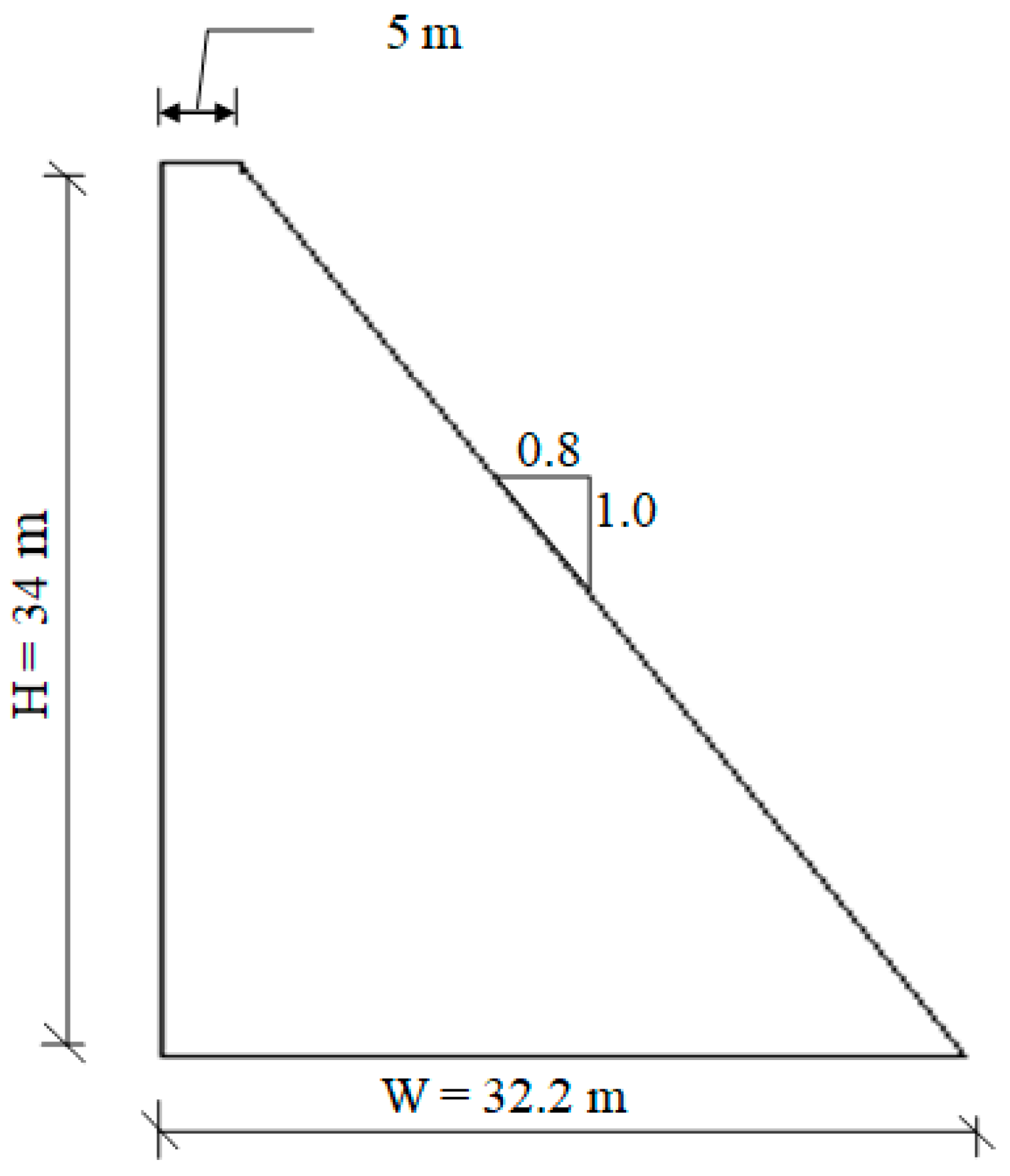
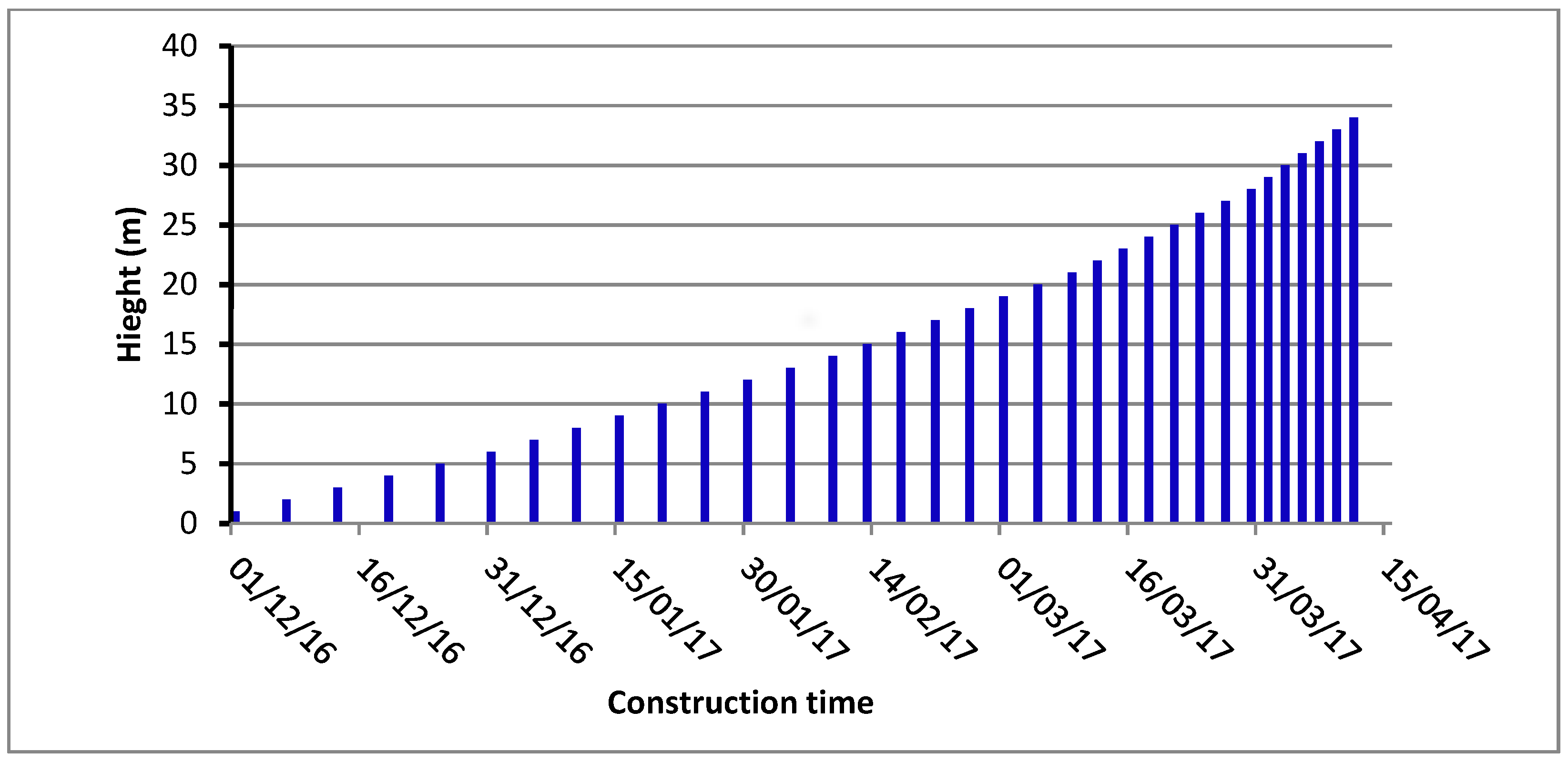
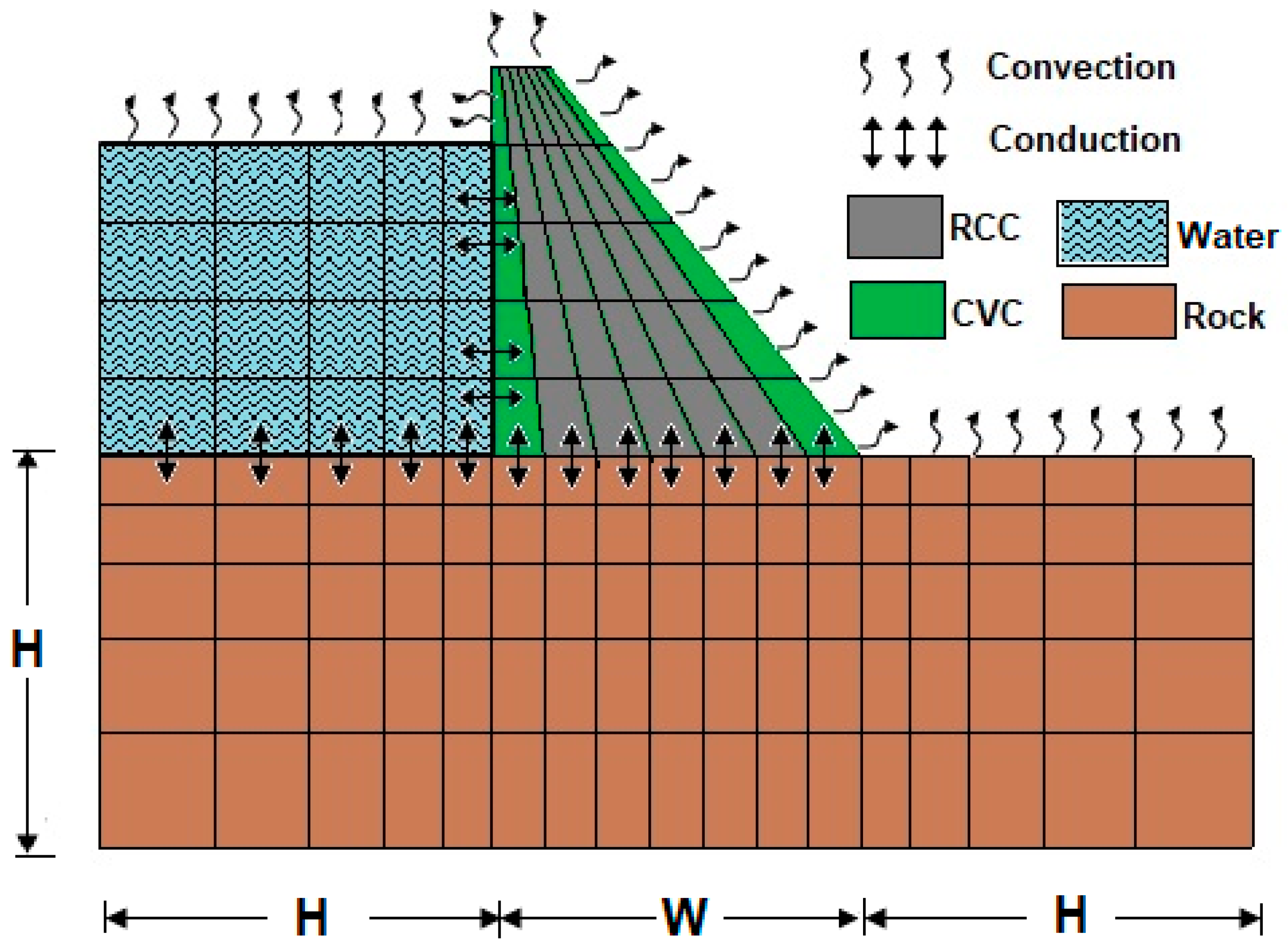
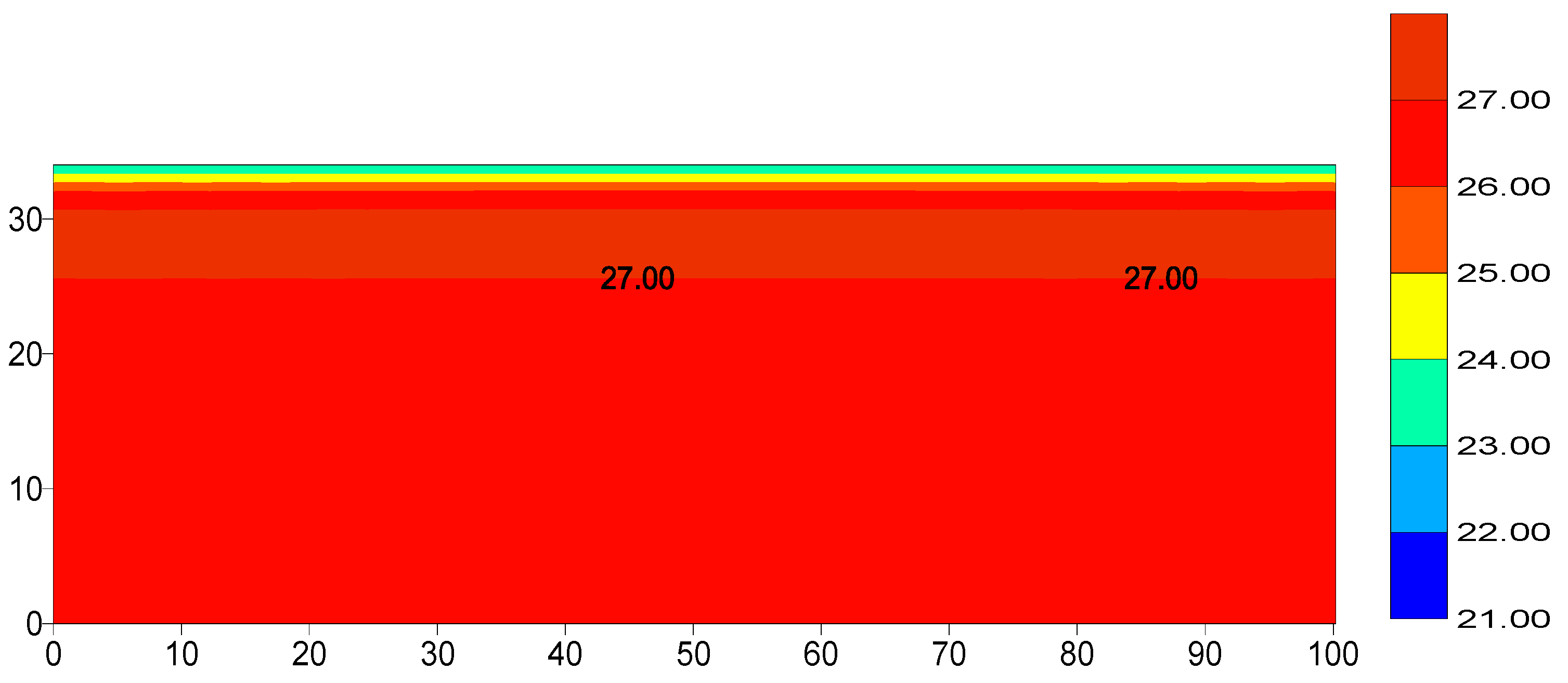

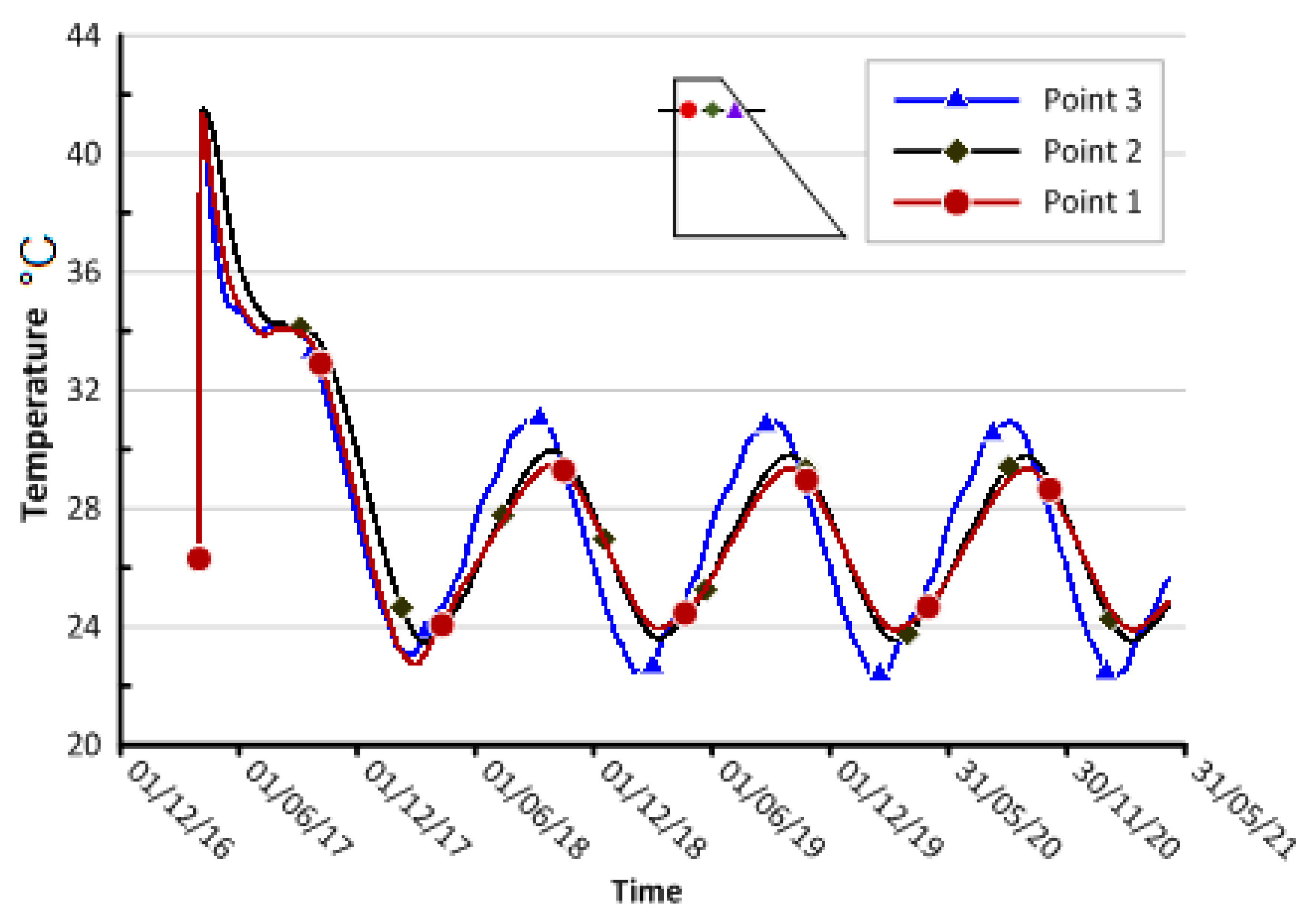
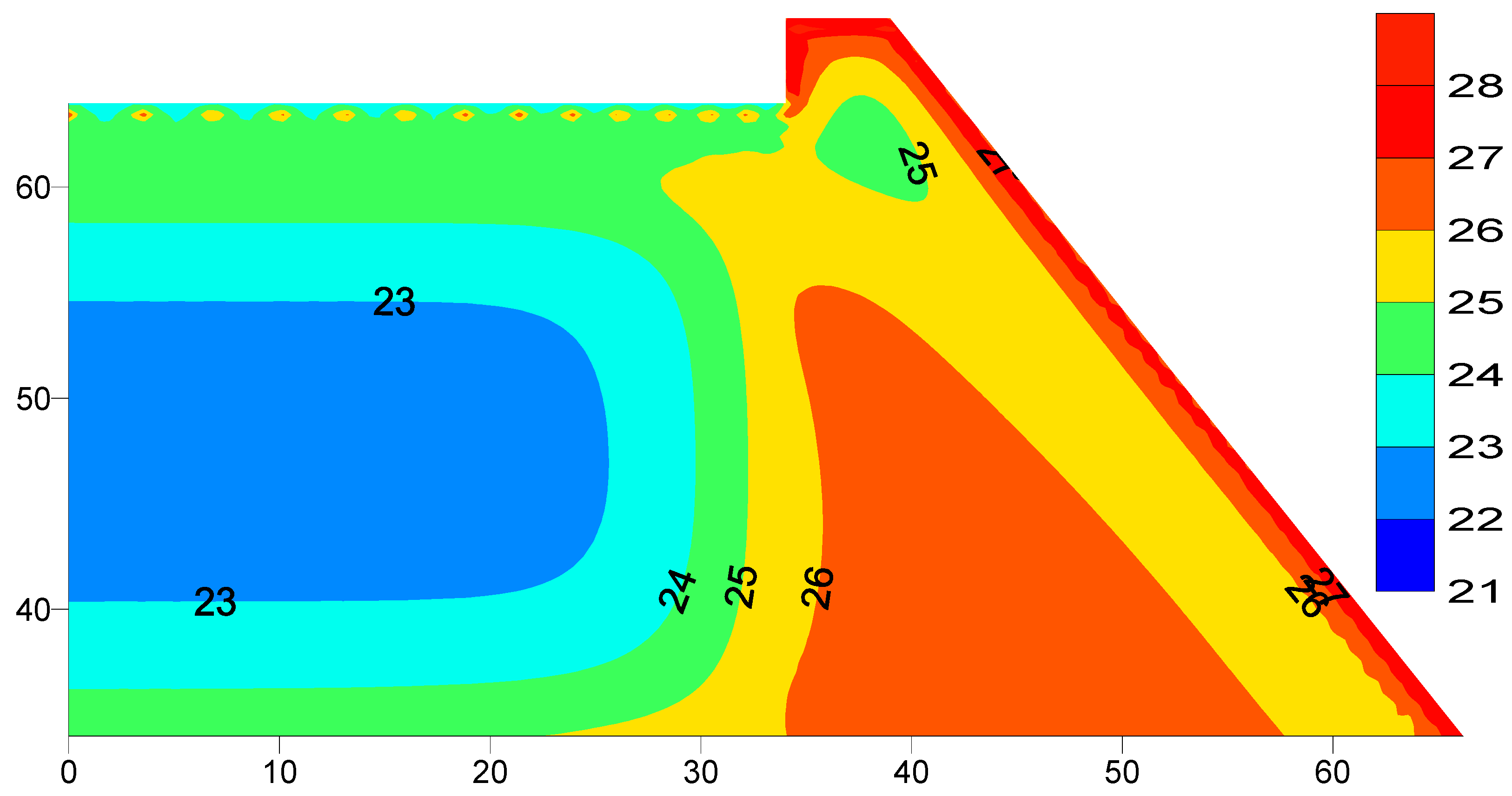
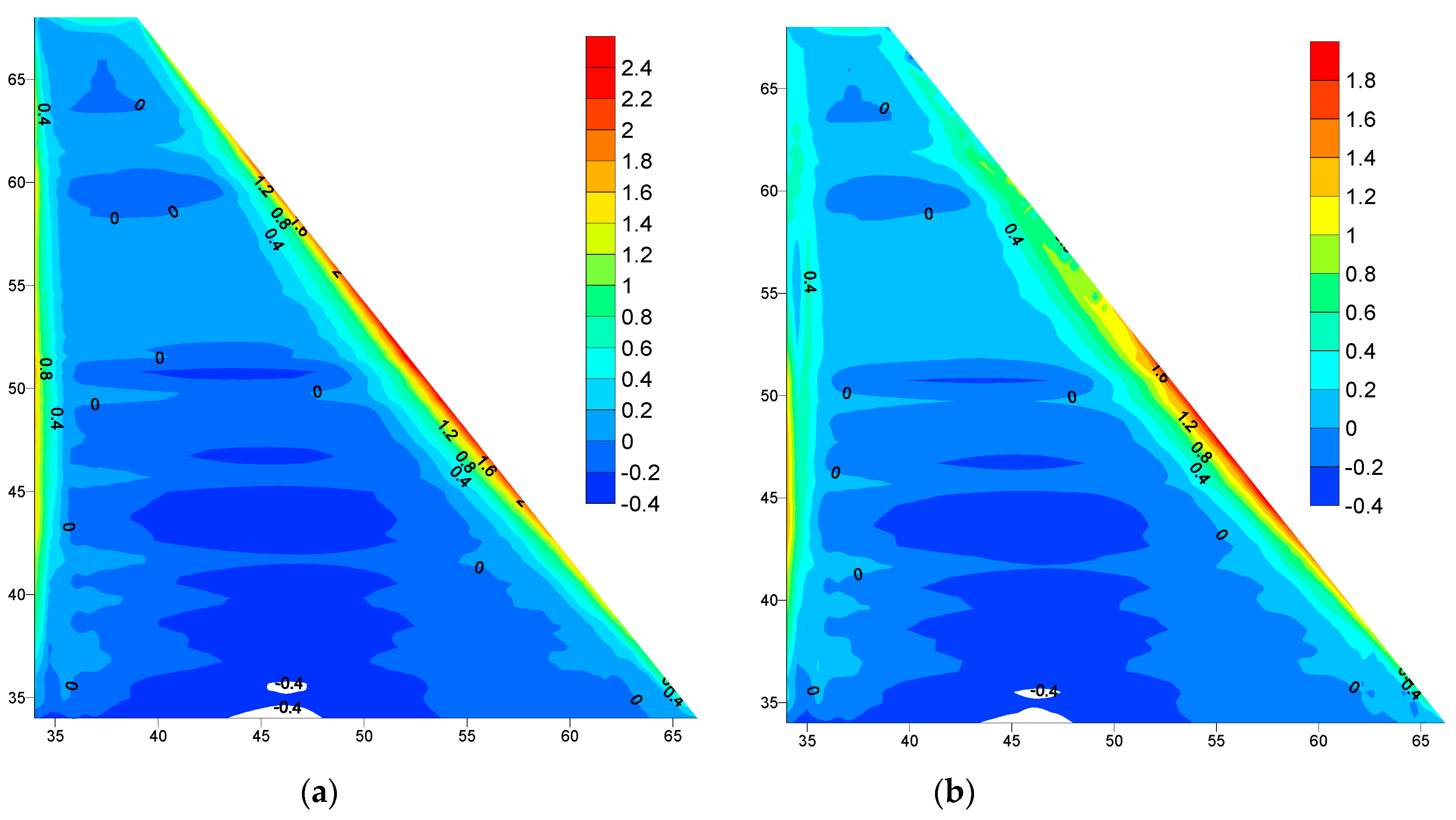

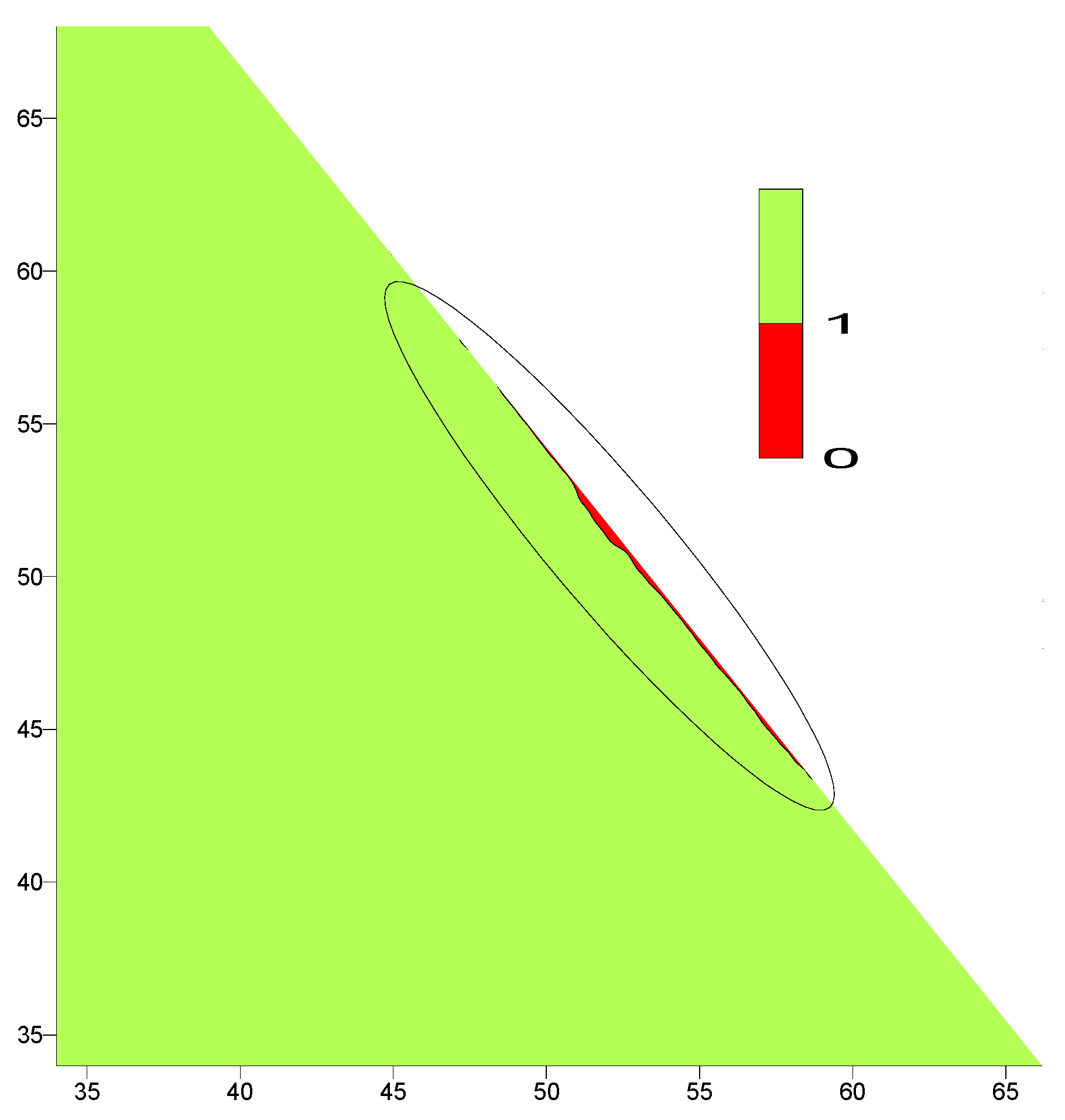
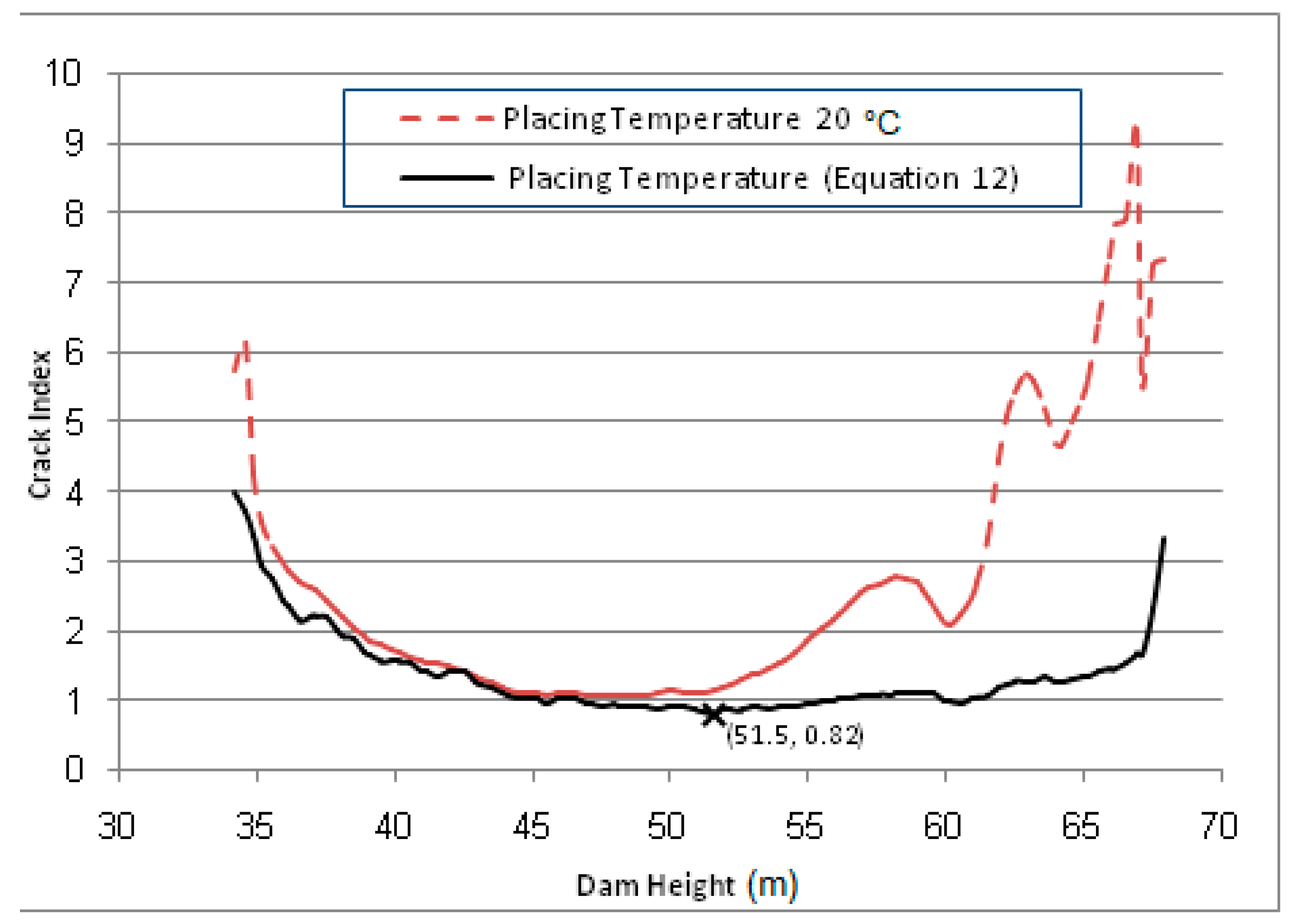
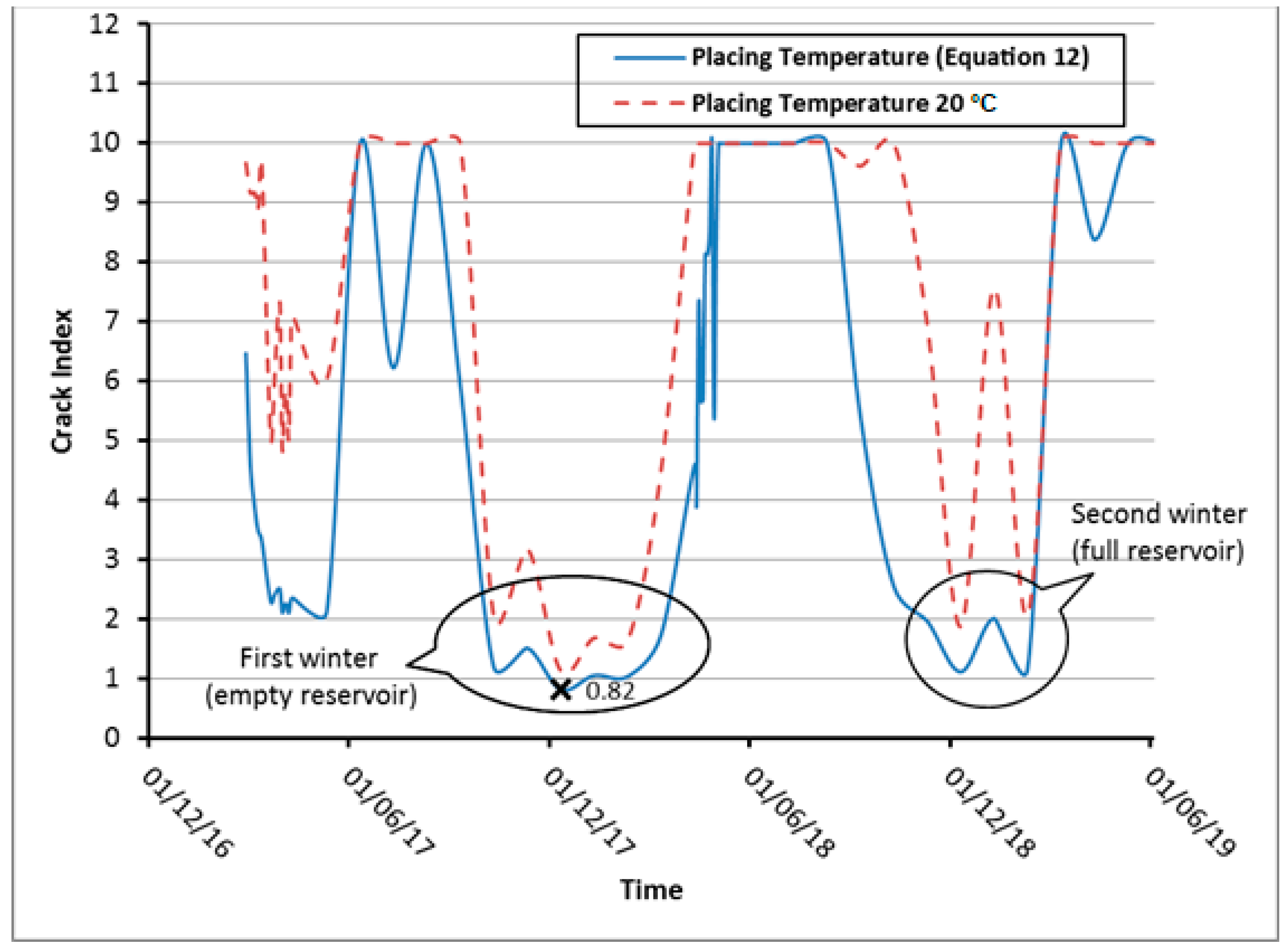
| Material | CVC | RCC | Rock | Water |
|---|---|---|---|---|
| Heat conduction coefficient, k(W/m·°C) | 2.8 | 2.7 | 2.97 | 0.615 |
| Heat convection coefficient, h(W/m2·°C) | 13.3 | 13.3 | 12 | 500 |
| Specific heat, c(J/kg·°C) | 1150 | 1150 | 1000 | 4810 |
| Density (kg/m3) | 2350 | 2325 | 2650 | 1000 |
| Elasticity modulus, E(Mpa) | 25000 | 18,200 | 24,000 | – |
| Poisson ratio (ν) | 0.2 | 0.2 | 0.2 | – |
© 2019 by the authors. Licensee MDPI, Basel, Switzerland. This article is an open access article distributed under the terms and conditions of the Creative Commons Attribution (CC BY) license (http://creativecommons.org/licenses/by/4.0/).
Share and Cite
Bayagoob, K.H.; Bamaga, S.O. Construction of Roller Compacted Concrete Dams in Hot Arid Regions. Materials 2019, 12, 3064. https://doi.org/10.3390/ma12193064
Bayagoob KH, Bamaga SO. Construction of Roller Compacted Concrete Dams in Hot Arid Regions. Materials. 2019; 12(19):3064. https://doi.org/10.3390/ma12193064
Chicago/Turabian StyleBayagoob, Khaled H., and S. O. Bamaga. 2019. "Construction of Roller Compacted Concrete Dams in Hot Arid Regions" Materials 12, no. 19: 3064. https://doi.org/10.3390/ma12193064





